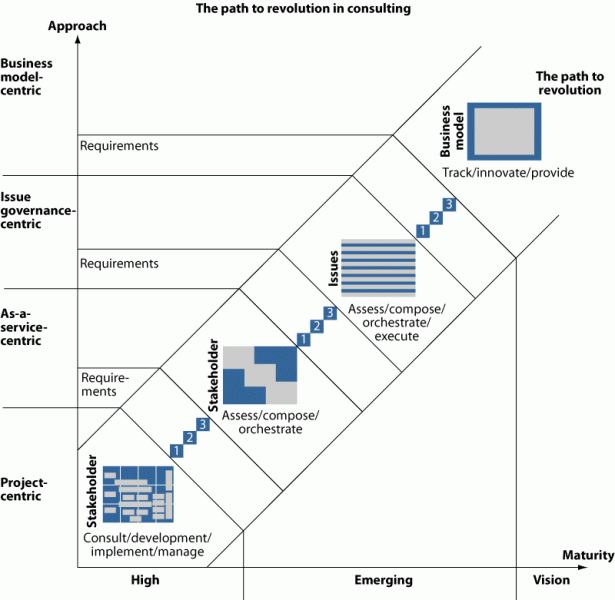The Path To Revolution In Management Consulting
This past May, I was on a plane when I created the first version of the path to revolution (see figure below) in management consulting, and which I am sharing with you today. This figure has not really changed much since then, but I have been developing the underlying structure to help me, as well as executives at consulting service providers, segment and map the new portfolio of existing and evolving services that have bubbled up in the wake of the increasing diversification of delivery options. My interactions with a number of executives over the past few months have helped me in this early validation process.
I recently started a discussion about what constitutes management consulting 2.0 in The Forrester Community For Vendor Strategy Professionals. This opened up the discussion on innovation in management consulting to a broader audience. While the community discussion has triggered quite a number of views (already more than 1,200 views), there are unfortunately just four (very valuable) responses so far. I encourage you to weigh in to the discussion (and to also check out others such as those on an apps-everywhere world and Smart Computing). You’ll also find new contributions from me there soon.
In the future, we will see four main approaches to delivering value to clients from management consulting service providers (which begs the question as to whether the phrase “management consulting” is not fading into obsolescence anyway):
- Project-centric approach. This is the traditional approach we all know; today, it is primarily pursued by consulting service providers and clients. This refers to Forrester’s business and IT services taxonomy, introduced in 2008, which maps service categories along three stakeholder categories: executive, line-of-business, and IT.
- As-a-service-centric approach. This is an emerging approach, which has two categories of services: platform-based intelligence/analytics services and platform-based consulting services. Examples include Deloitte Digital and Deloitte’s Subscription Analytics. McKinsey & Company’s recent moves also underline its push into this approach. Together with Nielsen, McKinsey has formed a joint venture, NM Incite, offering social media intelligence and consulting services. Partnerships like this are probably the [only?] key vehicle for classical consulting firms to overcome their rigid business and operating models and tap into new revenue opportunities. McKinsey Solutions, on the other hand, is a nice example of how to offer packaged consulting solutions via the Web.
- Issue-governance-centric approach. This is a highly nascent, but intriguing, approach. This is basically the issue-centric-bundling (for recurring dedicated corporate and/or operational issues) of strategy consulting with [platform] business process outsourcing (BPO), coupled with a high-outcome-based pricing orientation (check out a report on platform BPO from my colleague John McCarthy, which includes definitions and examples). Emerging services include Accenture’s Management Services. Accenture takes full responsibility for a corporate/operational issue of a client for a contract that is up to 100% results-based. For example, it governed the new growth program of a major manufacturer and has only been paid on the new incremental revenue realized. Capgemini, on the other hand, introduced its Procurement-as-a-Service offering earlier this year. It bundles a platform (the IBX On-Demand Platform) with Capgemini’s BPO and consulting service capabilities.
- Business-model-centric approach. As you can see in the figure below, I consider this approach to be visionary in terms of maturity, so I won’t describe yet how I understand this approach and how potential offerings would look like.

In the final report, I will outline the different approaches in more detail (terms may change — I am always looking for better suggestions). In the meantime, I would appreciate any questions/comments you might have. Don’t forget to check out our community discussion on the topic.
Best,
Daniel
Follow me: @daniel_krauss